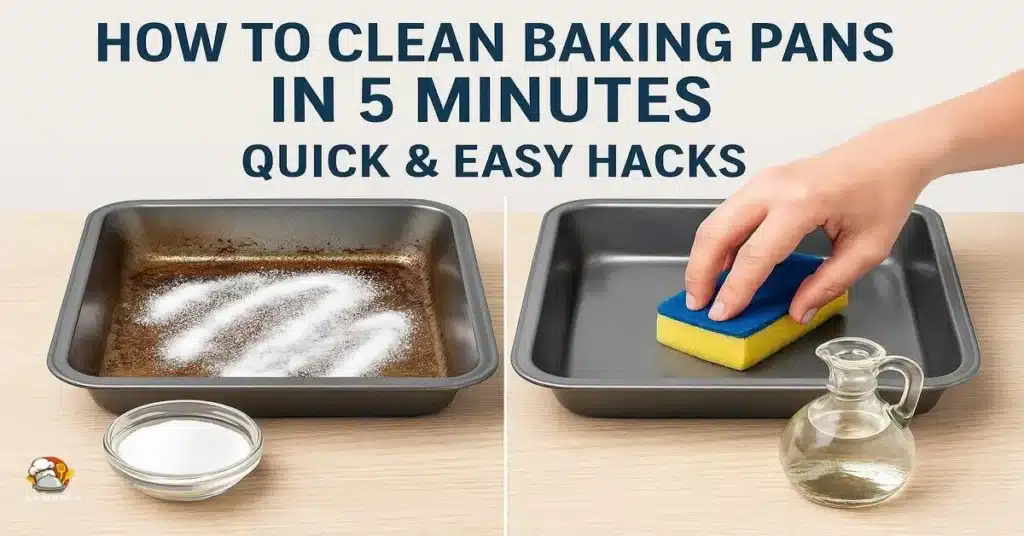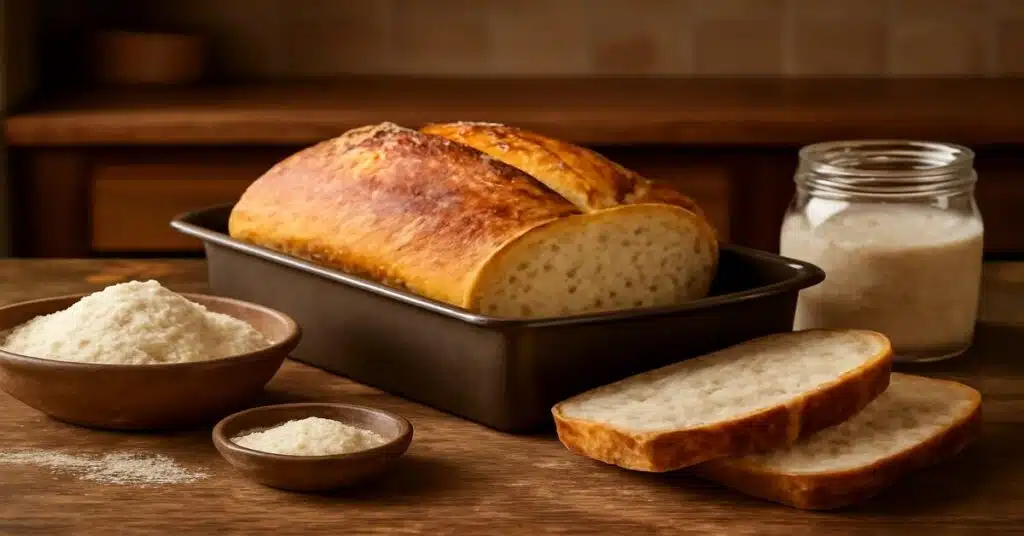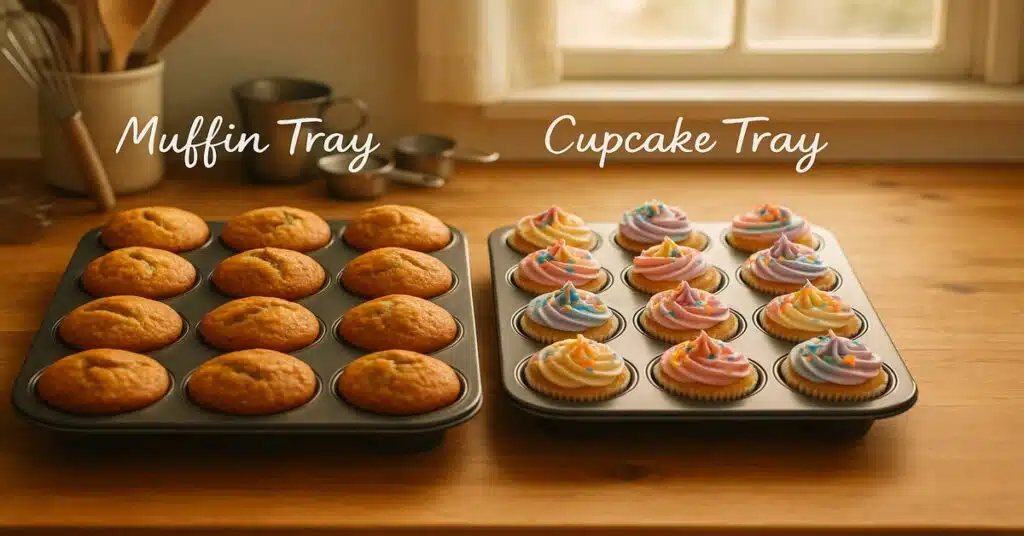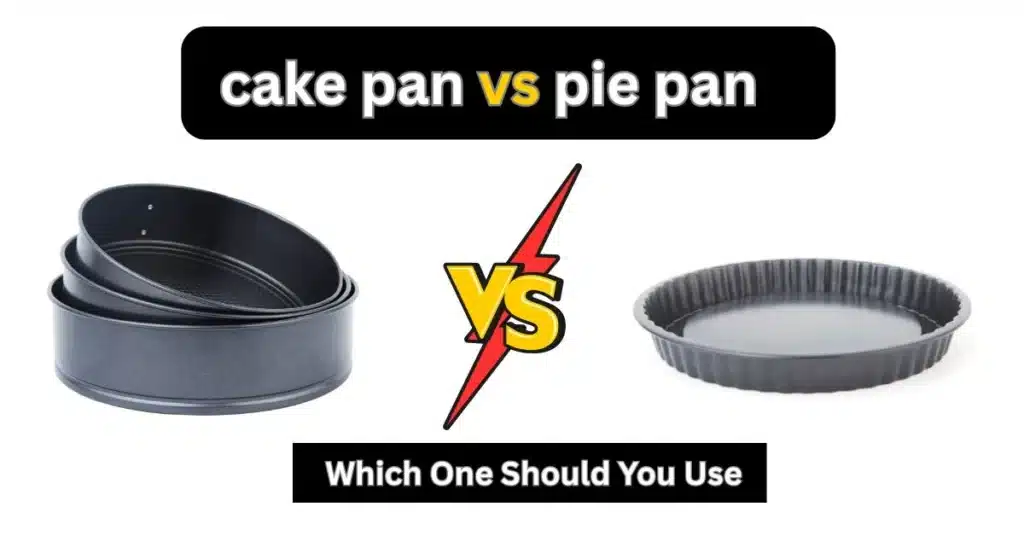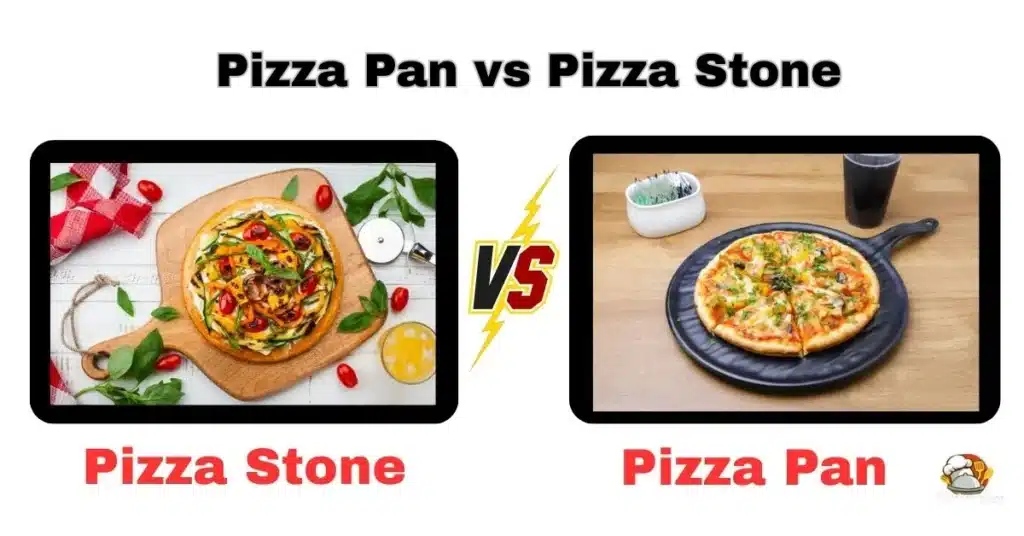Scrubbing greasy, burnt baking pans for hours is tiring—I know because I’ve been there many times. I often spent too long trying to scrape off grease stains and burnt food. It was frustrating when nothing worked.
That’s when I started trying quick, science-backed kitchen hacks. The results changed how I clean. In this guide, I’ll show you the quickest way to clean baking pans in 5 minutes using safe, simple tools you already have—like baking soda, vinegar, and lemon juice.
These aren’t random tips. They are easy cleaning methods I use myself. They can restore shine to your bakeware without harsh chemicals or endless scrubbing. By the end, your pans will look fresh again, and you’ll save time for what matters most—cooking and baking.
Quick Answer:
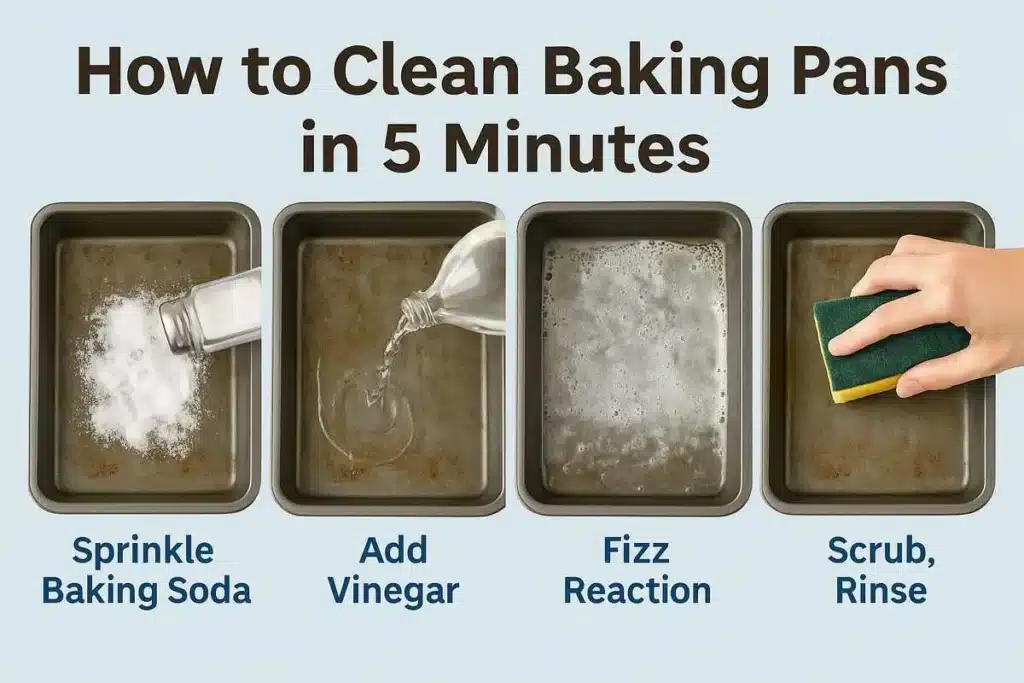
The fastest way to clean baking pans in 5 minutes is to sprinkle baking soda on the pan, pour vinegar, let it fizz for 1–2 minutes, then scrub gently with a soft sponge and rinse with warm water.
For an eco-friendly method, scrub the pan with lemon and salt to lift grease and remove odors.
For everyday grease, soak the pan in hot water with dish soap for 3 minutes before wiping clean.
These three simple hacks are quick, safe, and require only common kitchen ingredients.
Why Do Baking Pans Get Dirty So Quickly?
Even the best baking pans can look dull after a few uses. Why do baking pans get brown or stained so fast? The reasons are simple.
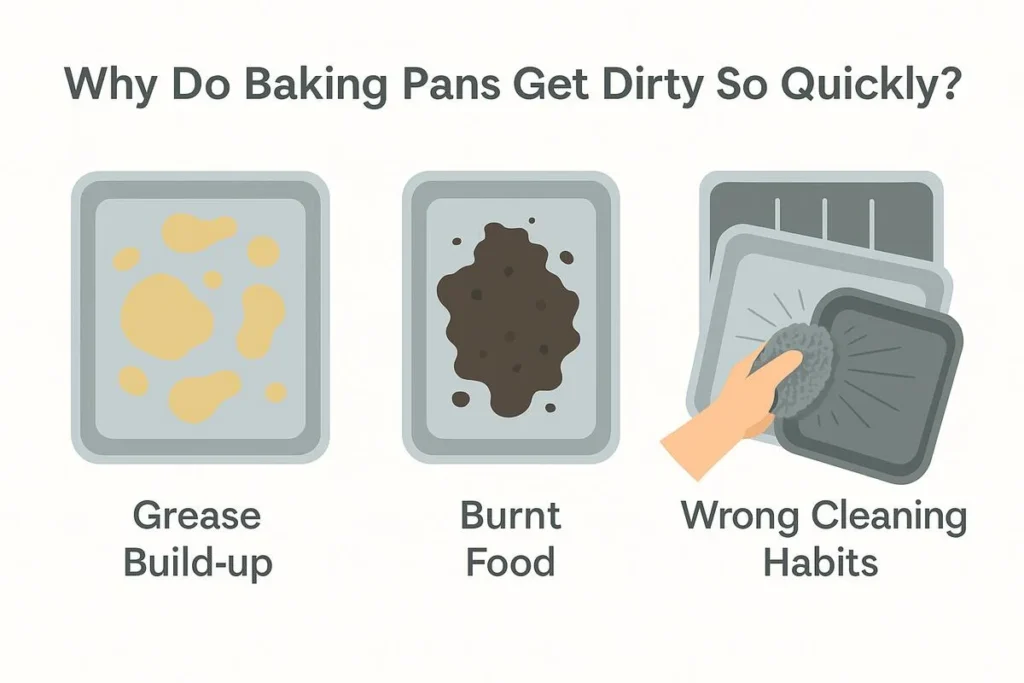
- Grease build-up: Oils drip during cooking and stick to the surface. This leaves tough grease stains that don’t wash off easily.
- Burnt food: High oven heat burns food into the pan. This creates stubborn residue that is hard to remove.
- Wrong cleaning habits: Scrubbing too hard, using steel wool on nonstick pans, or putting bakeware in the dishwasher when it isn’t safe can all damage the nonstick surface.
Over time, these problems don’t just cause pan discoloration—they also shorten the life of your bakeware.
Tip from my kitchen: I once ruined a nonstick tray by scrubbing it with steel wool. Since then, I always use soft sponges or a baking soda paste instead.
Quick 5-Minute Cleaning Methods
If you’re wondering how to clean baking pans in 5 minutes, here are three simple methods I use in my kitchen. Each one is fast, safe, and works on most bakeware.
Method 1 – Baking Soda + Vinegar Hack
Best for: Burnt-on stains and heavy grease
The fastest way to clean burnt baking pans is to sprinkle baking soda, pour vinegar, wait a minute, and scrub gently.
Steps:
- Sprinkle baking soda evenly over the pan.
- Pour vinegar on top so the fizzing reaction begins.
- Wait 1–2 minutes for the bubbles to loosen the stains.
- Gently scrub with a soft sponge.
- Rinse well with warm water to finish.
Result: Removes burnt stains, kills odors, and restores shine.
My tip: I always use this method after roasting chicken because it clears tough grease without hard scrubbing.
Method 2 – Lemon + Salt Scrub
Best for: Natural, eco-friendly cleaning
For a safe and eco-friendly solution, scrub the pan with lemon juice and salt for five minutes.
Steps:
- Cut a fresh lemon in half.
- Sprinkle salt over the dirty surface.
- Use the lemon to scrub in circles, letting the juice mix with the salt.
- Rinse with warm water after scrubbing.
Result: Lifts grease, brightens the pan, and removes odors.
My tip: This method works best on glass bakeware when I want it shiny and odor-free.
If you prefer sustainable tools in your kitchen, you might also want to check my guide on Are Silicone Baking Mats Safe? Read Before You Bake. They’re an eco-friendly option that reduces waste and keeps your pans cleaner for longer.
Method 3 – Dish Soap + Hot Water Soak
Best for: Everyday grease and light stains
To clean greasy baking pans daily, soak them in hot water with dish soap for three minutes, then wipe clean.
Steps:
- Fill the pan with hot water.
- Add a few drops of dish soap.
- Let it soak for about three minutes.
- Wipe with a sponge and rinse to finish.
Result: A quick, safe solution for daily grease removal.
My tip: I often rely on this method for cookie sheets, and it keeps them clean without much effort.
Comparison Table: Quick Cleaning Methods
| Method | Best For | Time | Safety |
| Baking Soda + Vinegar | Burnt-on stains | 5 min | Safe for all pans |
| Lemon + Salt Scrub | Eco-friendly option | 5 min | 100% natural |
| Dish Soap + Hot Water | Daily grease | 5 min | Very safe |
Cleaning Different Types of Bakeware
How should you clean different types of bakeware without causing damage?
The answer is simple—each type needs a slightly different method.
Nonstick Bakeware
- Best Practice: Never use steel wool or harsh scrubbers.
- Instead, clean with a soft sponge and dish soap to protect the nonstick surface.
- For stuck-on food, soak the pan in warm water before washing.
My tip: I scratched my first nonstick tray with a metal scrubber. Since then, I only use silicone or soft sponges.
Glass Bakeware (Pyrex)
- Best Practice: Soak in hot water mixed with baking soda for about 10 minutes.
- Always let the pan cool before cleaning—Pyrex can crack if exposed to sudden temperature changes.
- A lemon and salt scrub also works well to remove stains naturally.
My tip: I once cracked a glass dish by washing it too soon. Now, I always wait until it cools.
Ceramic Bakeware
- Best Practice: Most ceramic pans are dishwasher safe.
- Still, gentle hand-washing helps the ceramic coating last longer.
- Avoid abrasive pads to protect the smooth finish.
My tip: I prefer hand-washing my ceramic dishes with mild soap and a soft brush. It keeps them shiny for years.
Stainless Steel Pans
- Best Practice: For stubborn stains, use a baking soda paste or soak with vinegar.
- Scrub with a non-abrasive pad to avoid scratches.
- Polish with a microfiber cloth to restore shine.
My tip: I often use vinegar for water spots. It brings back the mirror-like shine on stainless steel.
Comparison Table: Cleaning Different Bakeware Types
| Bakeware Type | Best Method | Safety Tip |
| Nonstick | Soft sponge + dish soap | Never use steel wool |
| Glass (Pyrex) | Hot water + baking soda soak | Avoid sudden temperature changes |
| Ceramic | Gentle hand-wash | Do not use abrasives |
| Stainless Steel | Baking soda paste / vinegar soak | Use non-abrasive scrubbers |
Common Mistakes to Avoid
What are the most common mistakes people make when cleaning baking pans?
Even if you know how to clean baking pans, simple mistakes can damage them over time. Here are the biggest ones to avoid:
- Over-scrubbing nonstick pans: Scrubbing too hard with steel wool will scratch and destroy the nonstick coating.
- Using harsh chemicals: Strong cleaners strip away the surface and may leave harmful residue.
- Dishwasher misuse: Many pans are not dishwasher safe. High heat and detergent often cause dishwasher damage.
- Ignoring instructions: Always read the manufacturer’s cleaning guide before you wash or soak bakeware.
These cleaning mistakes for bakeware don’t just shorten pan life—they also make future cleaning harder and less effective.
My tip: I ruined one of my favorite nonstick pans by tossing it into the dishwasher. Since then, I always hand-wash my best pans with mild dish soap.
Preventive Care: Keep Your Baking Pans Clean Longer
How do you prevent grease stains and keep bakeware clean for years?
The easiest way to keep baking pans clean longer is to use protective layers like parchment paper or silicone mats, lightly grease before baking, and wash pans right after use.
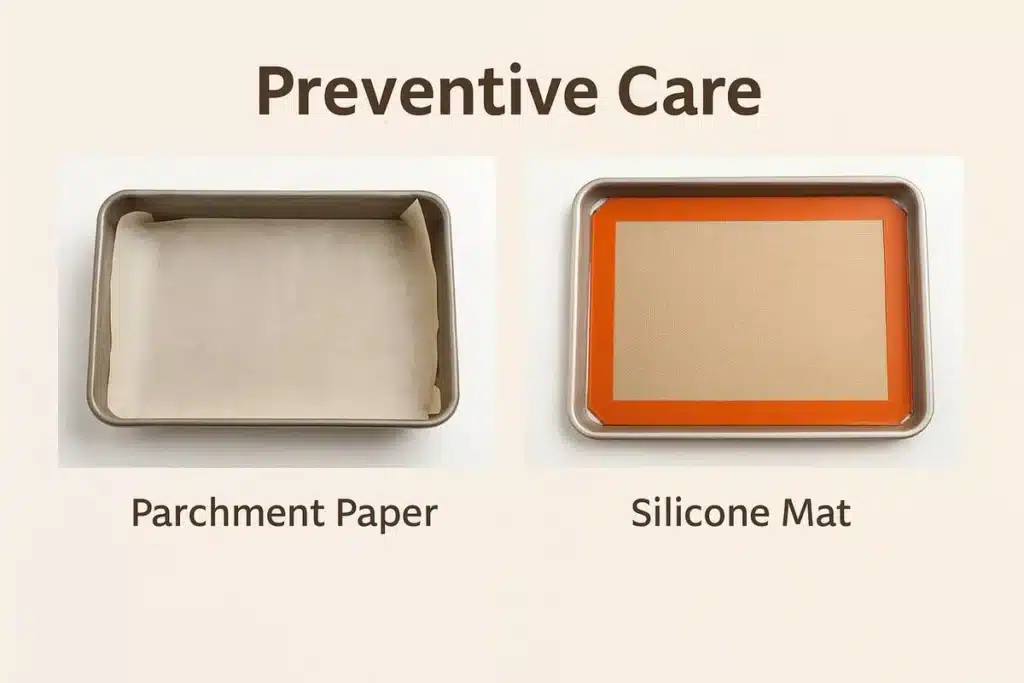
Here are some bakeware care tips I always follow:
- Use parchment paper or silicone baking mats: They create a protective layer, so grease and food don’t touch the pan directly.
- Lightly grease pans before baking: A quick spray of oil keeps food from sticking and makes cleaning much easier.
- Wash pans right after use: Never leave them soaking overnight, because food residue hardens and becomes harder to remove.
These habits not only prevent grease stains on baking pans but also extend the life of your cookware.
My tip: I keep silicone mats in my kitchen drawer. They save me scrubbing time and keep my pans looking new for years.
For more silicone tips, see my guide on How to Use a Silicone Muffin Pan (No More Sticking!). It’s a simple way to prevent food from sticking and reduce cleaning time.
Recommended Cleaning Products
What are the best cleaning products for baking pans?
The best cleaning products for baking pans are gentle, safe for nonstick surfaces, and effective against grease or stains. Here are some options I trust and use.
- OXO Good Grips Pan Scraper – Best nonstick bakeware cleaner. Works well on burnt spots without scratching the surface.
- Pyrex Cleaning Kit – Best for glass bakeware. Removes stains while keeping glass shiny and heatproof.
- Calphalon Nonstick Pan Cleaner – Gentle but effective. Perfect for restoring nonstick pans without damage.
- Nordic Ware Pan Protector Set – Best for long-term care. Prevents scratches when stacking pans in storage.
- Wilton Eco-Friendly Cleaning Brushes – Eco-friendly cleaning kit. A natural choice for customers who want green cleaning tools.
My tip: I’ve used the OXO scraper for years. It’s the only tool that cleans tough grease quickly without harming my pans.
Conclusion How to Clean Baking Pans in 5 Minutes
Yes, you can clean baking pans in just 5 minutes by using simple, safe kitchen hacks.
Cleaning pans doesn’t have to feel endless or frustrating. With these three quick cleaning methods—baking soda + vinegar, lemon + salt scrub, and dish soap soak—you can remove stains and restore shine without hours of scrubbing.
Remember: Prevention is always better than cure. Use parchment paper, silicone mats, and wash pans right after use to keep them clean and long-lasting.
My tip: I rely on these hacks in my own kitchen, and they have saved me many hours of scrubbing. Small changes in your cleaning routine make a big difference.
FAQs
What is the fastest way to clean baking pans?
The fastest way to clean pans is by using baking soda and vinegar. Sprinkle baking soda, pour vinegar, wait 1–2 minutes, and scrub lightly. This quick reaction removes burnt food in under 5 minutes.
How do you clean burnt baking pans with baking soda?
To clean burnt baking pans, make a paste of baking soda and water. Spread it on burnt spots, let it sit for 10–15 minutes, then scrub gently with a soft sponge. This baking soda cleaning hack works without harsh chemicals.
Can lemon juice clean grease stains?
Yes. Lemon juice mixed with salt breaks down grease naturally, removes odors, and restores shine. It’s eco-friendly and safe for most types of bakeware.
Is vinegar safe for nonstick bakeware?
Yes, vinegar is safe for nonstick bakeware if used in small amounts. However, avoid soaking for long periods because it may weaken the nonstick coating.
How do I keep pans from getting discolored?
Wash pans immediately after use, avoid overheating, and use parchment paper or silicone mats while baking. These habits prevent grease stains and reduce discoloration.
My tip: On weekends, I use lemon + salt for grease and baking soda + vinegar after roasting. Both are quick, safe, and always keep my pans looking new.
About the Author – MD Soazim
MD Soazim, founder of Kitchenpluse.com, shares practical cleaning hacks and bakeware care tips for home cooks. With hands-on kitchen experience, he shows simple methods like how to clean baking pans in 5 minutes so readers can save time and enjoy stress-free cooking.

